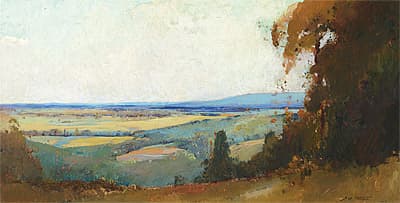
Sydney
LONG
Australia
1871
–
London
1955
England, Europe 1910-21; Australia 1921- 22; England 1922-25; Australia 1925-52; England from 1952
39.0 (h) x 76.5 (w) cm
signed and dated ‘Sid Long/ 1909’ lower right TBA Castlemaine Art Gallery & Historical Museum, gift of Lady Mary Spencer 1949
In many of his works, such as Pastoral landscape, Long sought to convey a feeling suggestive of a pastoral as rendered in music. In his article, ‘The trend of Australian art considered and discussed’, published in Art and Architecture 1905, he suggested that ‘the artist with imagination and a complete knowledge of his materials’ should be able to ‘produce work of the most imaginative kind from his surroundings’.
In Pastoral landscape, Long depicted a panoramic vista, viewing the multicoloured and neat fields of rich pasture from above to create a patterned effect. He carefully framed the landscape with a large, stylised, group of trees on the right and a smaller group on the left, with the open space below leading towards deep blue hills. The shadows in the foreground contrast with the sunlit fields and create a sense of depth.
Painted in oil on cardboard, with a degree of spontaneity in the handling, Long possibly produced this work in the open air directly in front of the motif.
Formerly known as ‘Narrabeen landscape’ this painting has been retitled ‘Pastoral landscape’ to indicate its pastoral nature, and because there is some doubt as to whether the subject is a view of Narrabeen.
In many of his works, such as Pastoral landscape, Long sought to convey a feeling suggestive of a pastoral as rendered in music. In his article, ‘The trend of Australian art considered and discussed’, published in Art and Architecture 1905, he suggested that ‘the artist with imagination and a complete knowledge of his materials’ should be able to ‘produce work of the most imaginative kind from his surroundings’.
In Pastoral landscape, Long depicted a panoramic vista, viewing the multicoloured and neat fields of rich pasture from above to create a patterned effect. He carefully framed the landscape with a large, stylised, group of trees on the right and a smaller group on the left, with the open space below leading towards deep blue hills. The shadows in the foreground contrast with the sunlit fields and create a sense of depth.
Painted in oil on cardboard, with a degree of spontaneity in the handling, Long possibly produced this work in the open air directly in front of the motif.
Formerly known as ‘Narrabeen landscape’ this painting has been retitled ‘Pastoral landscape’ to indicate its pastoral nature, and because there is some doubt as to whether the subject is a view of Narrabeen.
In many of his works, such as Pastoral landscape, Long sought to convey a feeling suggestive of a pastoral as rendered in music. In his article, ‘The trend of Australian art considered and discussed’, published in Art and Architecture 1905, he suggested that ‘the artist with imagination and a complete knowledge of his materials’ should be able to ‘produce work of the most imaginative kind from his surroundings’.
In Pastoral landscape, Long depicted a panoramic vista, viewing the multicoloured and neat fields of rich pasture from above to create a patterned effect. He carefully framed the landscape with a large, stylised, group of trees on the right and a smaller group on the left, with the open space below leading towards deep blue hills. The shadows in the foreground contrast with the sunlit fields and create a sense of depth.
Painted in oil on cardboard, with a degree of spontaneity in the handling, Long possibly produced this work in the open air directly in front of the motif.
Formerly known as ‘Narrabeen landscape’ this painting has been retitled ‘Pastoral landscape’ to indicate its pastoral nature, and because there is some doubt as to whether the subject is a view of Narrabeen.
